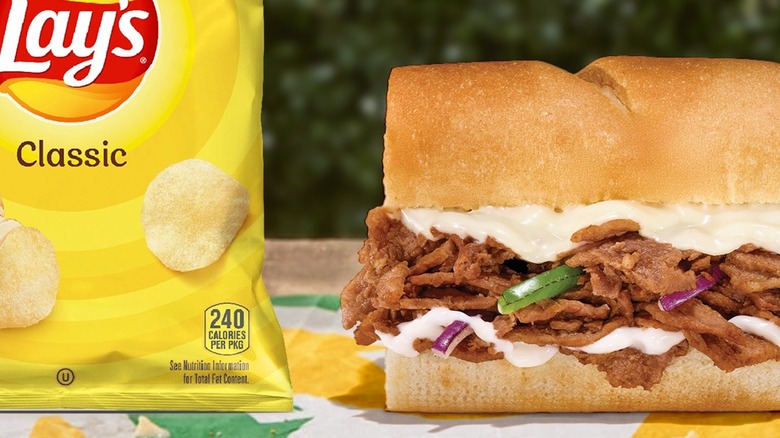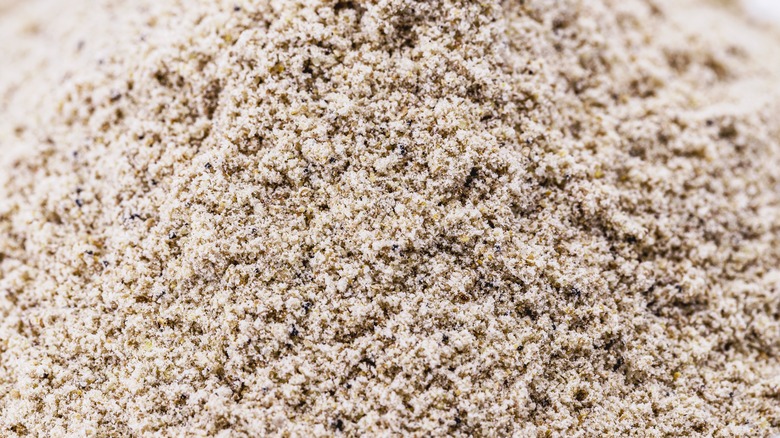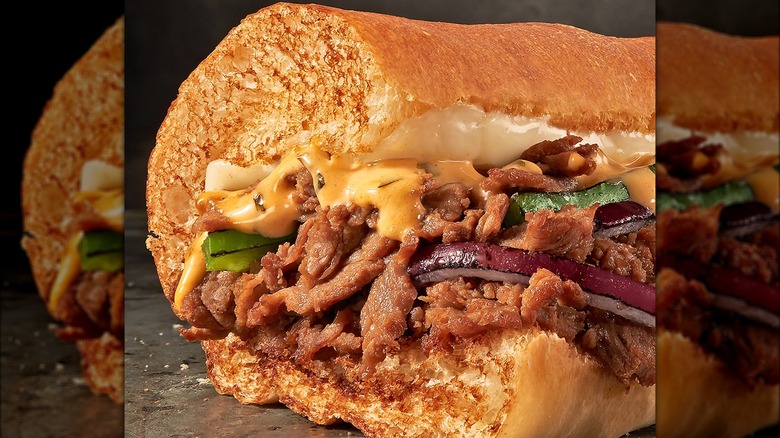All Your Questions About Subway's Steak Answered
There are two kinds of people in this world: There are the people who have their favorite, go-to order at Subway, and then there are the people who get something different every time. If it's steak that's on your personal menu, you might have some questions. And honestly? That makes sense. Steak isn't on a lot of fast food menus, and with all the hype, questions, and uproar that happened around Subway's tuna, a little healthy skepticism is to be expected.
If you've ever wondered what, exactly, you're being served when you order one of Subway's steak sandwiches, we've got you covered ... mostly. Interestingly, Subway is pretty secretive when it comes to sharing exactly what cuts go into the steak mix, but we do know that if you're going to make a copycat Subway steak and cheese at home, frozen sirloin will get you close to the real deal.
We did, however, uncover some other fascinating tidbits about Subway steak, including what's in it, how it's prepped, and what's going on with a recent lawsuit filed against the chain, with the steak right in the middle of things. Let's get to the bottom of your steak-related questions, and help you decide whether or not you're going to order one of these sandwiches the next time you head to Subway.
What, exactly, is in Subway's steak?
You'll probably remember the massive controversy that Subway found itself in when it had to dispute claims that the tuna was not actually 100% tuna, and here's the thing: The tuna filling for the sandwiches can't technically be 100% tuna, because it also contains things like mayo and seasoning. Makes sense, right? Similarly, there's a lot more to Subway's steak than just beef, and although that's the first — and main — ingredient, there's a surprising number of other ingredients, too.
According to the official list of ingredients for Subway, beef and water are the two main ingredients. The mix also includes things like citric acid, natural beef type flavor, maltodextrin, dried tomato, modified corn starch, soybean oil, and a slew of scientific-sounding ingredients like silicon dioxide, and disodium inosinate. That's not only something that applies to the steak, either. Subway's other meats — including the turkey breast and grilled chicken — have similar ingredients.
We're going to take a closer look at what some of those are and what they do, but it's also worth noting that Subway's steak has slightly different ingredients in other countries. Take a look at Canada's ingredients, for example, and you'll see lemon juice solids, onion powder, and garlic powder on the list as well. (Canada also has a Jerk-spiced steak which sounds downright delightful, and includes molasses, Jerk seasoning, spices, and smoke flavor as well.)
The steak tastes different: Has it changed?
After keeping the menu largely the same for a long, long time, Subway announced a massive menu overhaul in 2022. That included a number of new sandwiches, and in 2023, the chain also announced that it was installing meat slicers in many stores. There was a footnote to that, though: The steak was still going to be sent to stores pre-sliced.
That doesn't mean that the steak hasn't undergone some changes. Look back at the ingredient list from 2019 and you'll find some things that aren't on the 2024 version, including lemon powder, garlic powder, onion powder, and turmeric.
On the flip side, ingredients like caramelized sugar and scientific-sounding additives — like disodium guanylate and sodium hydroxide — have been added, and that's a little weird. At a time when consumers are more aware than ever of whether or not fast food chains are serving up high-quality beef in their burgers, Subway seems to have added even more additives and hard-to-pronounce ingredients to its steak.
What are all these additives for?
Let's take a closer look at some of the ingredients that are in Subway's steak, and see if we can figure out why they're there. Some — like sodium phosphate, maltodextrin, citric acid, and sodium hydroxide – are used as preservatives, which is similar to why cultured sugar often shows up in foods. That's in Subway's steak, too, and it's used to prevent mold growth. As for hydrolyzed corn protein, that's usually added as a flavor enhancer. Even though it's made from corn, it's known for adding umami to foods, particularly meats and gravies.
That's a lot of added preservatives, and if you're wondering why Subway's steak — and many other types of processed foods — have different types of additives that seem to do the same thing, there's an answer for that. Different preservatives act in different ways. Some prevent mold growth, some are antibacterial, some slow the oxidation and spoilage processes, and some preserve color, texture, or flavor.
Silicon dioxide is generally used in food to act as an anti-clumping agent, and similarly, modified corn starch is used to preserve texture during cooking. Now, what about caramelized sugar? That's exactly what it sounds like, it is made by heating and caramelizing sugars, and it's added as both a flavor enhancer and coloring agent.
What the heck is autolyzed yeast?
Meat products probably aren't the first thing you think of when you hear yeast is one of the ingredients, so let's take a closer look at why this is in Subway's steak. First, let's clarify: Yes, this starts out as the same sort of yeast that's used in breads and brewing. That yeast is subjected to a process that separates the parts of the cell, after enzymes in the yeast further break down the proteins, and one of the things that's left is glutamic acid.
That acts just like MSG to enhance flavor ... sort of. Autolyzed yeast can change the flavor of what it's added to while MSG is flavorless, and a manufacturer might use yeast extract instead of MSG because they don't have to label the product as containing monosodium glutamate, which is slowly seeing a revival and recovery from a campaign of unjust vilification. With that in mind, though, the same foods also can't be labeled as having no MSG.
Why use it in steak? Some studies suggest that in addition to a flavor boost, autolyzed yeast also improves the texture of processed meats, and there's another reason to opt for this ingredient, too. Manufacturers can usually use less autolyzed yeast to get the desired effect, but because it's high in sodium, some people looking to limit their sodium intake might want to keep an eye out for this one.
What is the beef flavoring in my beef?
It's a weird thing to see "Natural Beef Type Flavor" being added to a product that is literally mostly beef, so what gives? Interestingly, Subway lists some of the individual ingredients of its beef flavoring — including autolyzed yeast — and also describes another ingredient as just "Natural Flavor." That's not unusual, and federal legislation says that as long as flavoring agents are FDA-approved and they're not allergens, they don't have to be labeled.
The science of added flavors is pretty neat, and it's essentially the chemistry of putting together amino acids and other components that mimic the taste of beef — and sometimes, it's entirely vegetarian. Many of the compounds connected with beef flavoring have complicated, science-y names, like Bis(2-methyl-3-furyl) disulfide (which is associated with the smell of roasting meat), and nona-2(E)-enal (which adds fatty flavors). That sounds weird, but even weirder is the argument that these laboratory-created compounds might even be better for you than naturally-occuring flavors, because they're more strictly regulated.
Why would Subway add beef flavoring to beef? We couldn't find a definitive answer, but we can take a guess. Not all beef tastes the same, and even the meat from individual cattle taken from the same herd might have a different flavor. Beef flavoring formulated in a lab to have the same taste might help with consistency, and for a chain restaurant, consistency is a big deal.
How much steak are we supposed to get on a sandwich? (And, what's with the lawsuits?)
We've all been out at a restaurant, been served our food, and then wondered where the rest of it is. When it comes to Subway's steak, you might be surprised to know just what a portion is, because it's not much. A breakfast-sized serving of steak is just 1 ¼ ounces, and for the subs, it's just a 2 ½ ounce serving size. Subway uses a few different methods of measuring, including specially-sized scoops and "boats," which are basically small dishes where portions are weighed out.
Still, that attempt at standardization hasn't stopped some major complaints. In October 2024, a class action lawsuit was filed against Subway claiming that the Steak and Cheese subs were depicted in advertising as allegedly having much more meat than customers who ordered them actually got. At the time of this writing that lawsuit has just been filed in New York, so the outcome remains to be seen.
Bizarrely, a similar lawsuit was filed in Philadelphia less than two weeks later. This, too, was a class action lawsuit that specifically named the Steak and Cheese sub as allegedly being sorely lacking in the meat department, especially when compared to the images used in advertising. Plaintiffs claimed that if the sub was advertised truthfully they never would have considered buying it, and the decisions in these lawsuits could have an impact on fast food advertising going forward.
How does Subway prep the steak?
When a video showing steak prep at Subway was uploaded to TikTok in 2024, there were a number of headlines suggesting that customers were shocked at what they saw. The video showed an employee opening a plastic bag of pre-shredded meat, mixing it up to break it apart, and then weighing it out into portion sizes.
Shocking? Maybe, but it was certainly nothing new. Training videos for Subway have been available on YouTube for several years, and they've shown the same process. The steak gets to the restaurant in a plastic bag, employees need to break it up into even and loose shreds, before transferring it into the containers that would go behind the counter.
It seems as though the chain has no intention of changing the way that it's making and delivering the steak. Although it was announced that about 20,000 Subway locations were going to be installing and using meat slicers for the cold cuts, the steak, rotisserie chicken, and cheese were unaffected by the change.
What do we know about nutritional information?
Subway's nutritional information is pretty helpful, as it lists not only the totals for specific subs, but for individual ingredients as well. What are you getting with one serving of steak?
That single portion of steak comes with 110 calories, 5 grams of fat, and 450 milligrams of sodium. That might not mean too much, but let's put that in context: According to the American Heart Association, most Americans have way too much sodium in their diets and should be aiming for no more than 2,300 milligrams per day, with a best-case scenario of limiting sodium to 1,500 milligrams per day. That means that a single serving of steak is ⅓ of the ideal, and when you look at the total for Subway's 6-inch Philly sub, that's about 1,300 milligrams of sodium.
That nutritional information isn't for every Subway, either. If you look at the numbers for other countries, you'll find they're pretty different. Take Ireland. There, a serving of steak has 86 calories, 1.4 grams of fat, and 700 milligrams of sodium, and it's a fascinating look at how ingredients that are used by the same chain and seemingly similar can be very, very different in other countries.
How is it doing in that promise to go antibiotic-free?
Way back in 2015, Subway made an announcement promising to eliminate antibiotics from all meats used in the chain. The plan was to start with chicken, and in a gradual change, Subway promised that the plan would culminate with an end to antibiotics in beef — a promise that was supposed to wrap up in 2025. It was wildly ambitious, and at the time, Subway was one of the nation's largest fast food chains.
In the announcement, Subway said it hoped the move would encourage other chains to do the same, and in 2016, the move gave them a massive boost on the Chain Reaction report on transparency of meat sourcing and antibiotic use. Subway — along with Chick-fil-A — was given a "B" grade, while many other chains sat at an "F." Fast forward to 2019, though, and Subway had dropped a full letter grade, which it reportedly held onto for promises to rid their beef products of antibiotics.
Things were looking even more disappointing in 2021, when another Chain Reaction report saw Subway holding onto that "C" grade for the policies that were on-point, but there was a massive footnote to that, too: They hadn't actually gotten around to putting any of them into practice. Details of just where Subway is in the process of getting rid of antibiotics use in beef and steak are unclear: As of this writing in November 2024, Subway's official website states that the target end date of 2025 still stands.
Can you order the steak by itself ... and should you?
Sure, you can stop into Subway and order steak on a sub, but did you know that you can also order just a side of steak? You absolutely can: According to employees on Reddit, you won't even be making their job complicated, as there's an easy way for a side of steak to be rung up on the register. That's great news if you'd like some extra steak on your sub, but according to other intrepid Redditors, there's an even better use for that steak.
Almost every restaurant has a secret menu, and some secret menus are good, and some are bad. Subway fans say that the steak is at the heart of a stellar secret menu item that involves a bag (or two) of Doritos, steak, and cheese to make some downright delicious nachos. Want to take it to the next level? You're already at Subway, so make the most of it: olives, jalapeños, tomatoes, even a dash of ranch dressing can make some seriously amazing nachos.
Doritos are also an excellent addition to a steak sub, and if you're familiar with the idea of a Frito pie, it turns out that Subway's steak is pretty delicious in a Dorito-based version of that, too. Crush your bag of chips, add your steak and other toppings, and you've got a lunch that's definitely not boring.
How does the steak sandwich compare to Subway's other offerings?
There's some bad news here for anyone who swears by Subway's steak, and that's the fact that steak has earned spots on a few Mashed round-ups. That includes a piece on things that you should never order at Subway, where a registered dietician calls out the steak, egg, and cheese breakfast sandwich for being small, unsatisfying, and yet still containing 18 grams of fat. The Philly and The Monster cheesesteak subs also make it onto the ranking of the unhealthiest Subway sandwiches, alongside subs with names like The Beast.
Surprisingly, although Subway's steak contains about a third of the American Heart Association's recommended daily intake for sodium, it's not the worst choice on the menu as far as proteins go. The steak clocks in at 450 milligrams of sodium per serving size for a 6-inch sub, while the Buffalo chicken has 900 milligrams. That's followed closely by the meatballs (720 milligrams), and the cold cuts, which average between 650 and 690 milligrams. The steak is also lower in fat than other meats, containing 5 grams compared to meatballs (about 18 grams), and the egg patty (15 grams).
While there might not be as many premade sandwich options when it comes to steak, it's still a respectable option. As a bonus, it's also often featured in limited edition menu items like the Cheesy Garlic Steak. For those who love to mix it up at lunch, that's a definite bonus.











